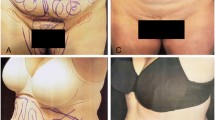Abstract
Background
Advances in suction-assisted lipectomy (SAL) include improved instrumentation, better understanding of fluid dynamics, and an improved concept of appropriate indications. The tumescent technique uses subcutaneous injection of isotonic fluid containing vasoconstrictive and analgesic agents and is proved to be safe, with low morbidity and mortality rates. Laser-assisted liposuction (LAL) using local infiltration of an anesthetic and no general anesthesia or sedation has been developed, with claims of fat destruction and skin tightening. This study aimed to review 1,000 consecutive cases of LAL and SAL performed with the patient under local anesthesia and to determine whether this represents a safe technique with few complications.
Methods
During a period of 22 months, 581 consecutive patients (486 females and 95 males) underwent 1,000 LAL/SAL operations, 545 of whom had multiple procedures performed. None of the patients had a body mass index (BMI) higher than 30 kg/m2. The patients ranged in age from 18 to 62 years. The fat aspirate ranged from 50 to 1,400 ml. Patients were given an oral sedative, an antibiotic, and an analgesic. Ringer’s lactate solution containing lidocaine and epinephrine was injected into the subcutaneous space. The 1,064-nm and/or 1,320-nm neodymium:yttrium-aluminum-garnet (Nd:YAG) laser was used for laser lipolysis followed by SAL using standard and/or power-assisted liposuction (PAL) cannulas. The treated areas included the neck, triceps, male breast, midback, flanks, axilla, abdomen, mons pubis, thighs, presacrum, and knees. No patient was administered intravenous sedation or general anesthesia.
Results
The average number of areas treated was 1.8, and no major complications or mortalities were observed. There were three burns, two infections, one hematoma, and one seroma. A total of 73 secondary procedures were performed (7.3%). No tertiary procedures were required.
Conclusion
For appropriately selected patients, comparable results can be obtained with an excellent safety profile and short recovery period using LAL and SAL with the patient under local anesthesia. The awake patient is able to participate in body positioning and to provide physiologic monitoring. No major complications occurred in this series. The burn and hematoma complications occurred in the first 25 cases and may have been related to a learning curve. One case of cellulitis occurred in the triceps region, and a second infection occurred in the abdomen. Both responded to antibiotics. Altogether, 73 touch-up procedures (7.3%) were performed. The amounts of fat removal were comparable with the volumes obtained using traditional liposuction. In conclusion, this series demonstrated that LAL/SAL using local anesthesia is a safe procedure for selected patients, with acceptably low morbidity and revision rates.
Level of Evidence IV
This journal requires that authors assign a level of evidence to each article. For a full description of these Evidence-Based Medicine ratings, please refer to the Table of Contents or the online Instructions to Authors at www.springer.com/00266






Similar content being viewed by others
References
Barillo DJ et al (1998) Fatal and near-fatal complications of liposuction. South Med J 91:487–492
Grazer FM, de Jong RH (2000) Fatal outcomes from liposuction: census survey of cosmetic surgeons. Plast Reconstr Surg 105:436–446 discussion 447–448
Teimourian B, Rogers WB III (1989) A national survey of complications associated with suction lipectomy: a comparative study. Plast Reconstr Surg 84:628–631
Klein JA (1993) Tumescent technique for local anesthesia improves safety in large-volume liposuction. Plast Reconstr Surg 92:1085–1098 discussion 1099–1100
Hanke CW, Bernstein G, Bullock S (1995) Safety of tumescent liposuction in 15,336 patients: national survey results. Dermatol Surg 21:459–462
Habbema L (2009) Safety of liposuction using exclusively tumescent local anesthesia in 3,240 consecutive cases. Dermatol Surg 35:1728–1740
Matarraso A, Hutchinson O (2001) Liposuction. JAMA 285:266–268
Apfelberg DB (1996) Results of multicenter study of laser-assisted liposuction. Clin Plast Surg 23:713–719
DiBernardo B, Reyes J, Chen B (2009) Evaluation of tissue thermal effects from 1,064/1,320-nm laser-assisted lipolysis and its clinical implications. J Cosmet Laser Ther 11:62–69
Mann MW, Palm MD, Sengelmann RD (2008) New advances in liposuction technology. Semin Cutan Med Surg 27:72–82
Prado A, Andrades P, Danilla S, Leniz P, Castillo P, Gaete F (2006) A prospective, randomized, double-blind, controlled clinical trial comparing laser-assisted lipoplasty with suction-assisted lipoplasty. Plast Reconstr Surg 118:1032–1045
Rohrich RJ, Beran SJ, Kenkel J, Adams WP, DiSpaltro F (1998) Extendingthe role of liposuction in body contouring with ultrasound-assisted liposuction. Plast Reconstr Surg 101:1090–1102
Dillerud E (1991) Suction lipoplasty: a report on complications, undesired results, and patient satisfaction based on 3,511 procedures. Plast Reconstr Surg 88:239–246
Dang Y, Ren Q, Liu H, Zhang J (2005) Comparison of histologic, biochemical, and mechanical properties of murine skin treated with the 1,064-nm and 1,320-nm Nd:YAG lasers. Exp Dermol 14:876–882
Katz BE, Bruck MC, Coleman WP III (2001) The benefits of powered liposuction versus traditional liposuction: a paired comparison analysis. Dermatol Surg 27:863–867
Scuderi N, Paolini G, Grippaudo Fr, Tenna S (2000) Comparative evaluation of traditional, ultrasonic, an pneumatic-assisted lipoplasty: analysis of local and systemic effects, efficacy, and costs of these methods. Aesthetic Plast Surg 24:395–400
Boeni R (2011) Safety of tumescent liposuction under local anesthesia in a series of 4,380 patients. Dermatology 222:278–281
Disclosures
Christopher T. Chia and Spero J. Theodorou are consultants for Cynosure Corporation.
Author information
Authors and Affiliations
Corresponding author
Rights and permissions
About this article
Cite this article
Chia, C.T., Theodorou, S.J. 1,000 Consecutive Cases of Laser-Assisted Liposuction and Suction-Assisted Lipectomy Managed With Local Anesthesia. Aesth Plast Surg 36, 795–802 (2012). https://doi.org/10.1007/s00266-012-9885-2
Received:
Accepted:
Published:
Issue Date:
DOI: https://doi.org/10.1007/s00266-012-9885-2




